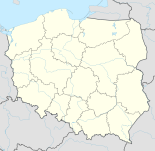Canki
| Canki | ||
|---|---|---|

|
|
|
| Basic data | ||
| State : | Poland | |
| Voivodeship : | Warmia-Masuria | |
| Powiat : | Giżycko | |
| Gmina : | Ryn | |
| Geographic location : | 53 ° 57 ' N , 21 ° 35' E | |
| Residents : | ||
| Postal code : | 11-520 | |
| Telephone code : | (+48) 87 | |
| License plate : | NGI | |
| Economy and Transport | ||
| Street : | DK 59 : Giżycko ↔ Ryn - Mrągowo - Rozogi | |
| Rail route : | no rail connection | |
| Next international airport : | Danzig | |
Canki ( German Waldhof ) is a settlement ( Polish osada ) in the Polish Warmian-Masurian Voivodeship , which belongs to the urban and rural municipality Ryn (Rhine) in the powiat Giżycki ( Lötzen district ).
Geographical location
Canki is located in the eastern center of the Warmian-Masurian Voivodeship , 16 kilometers southwest of the district town Giżycko (Lötzen) and two kilometers northeast of the city of Ryn (Rhine) .
history
The small and before 1823 Zankmichel , after 1823 Zankenicht called Gutsort was mentioned in 1818 as a "forest house" with a single fireplace for 12 souls, in 1839 as a combing property of the city of Rhine with four fireplaces for 40 souls. In 1874 he was appointed to the newly created District Orlen ( Polish Orlo incorporated), which - in 1938 in the district of Arlen renamed - existed until 1945 and the county Lötzen in Administrative district Gumbinnen (1905-1945 Administrative district Allenstein ) the Prussian province of East Prussia belonged.
Between 1874 and 1913 Waldhof belonged to the registry office in Orlen , then until 1945 to the registry office of the city of Rhine . In 1910 the Waldhof manor district had 74 inhabitants. Due to the provisions of the Versailles Treaty , the population in the Allenstein voting area , to which Waldhof belonged, voted on July 11, 1920 on whether they would continue to belong to East Prussia (and thus to Germany) or join Poland. In Waldhof, 60 residents voted to remain with East Prussia, Poland did not receive any votes. On September 30, 1928, Waldhof lost its independence and was incorporated into the rural community of Orlen (1938–1945 Arlen).
As a result of the war, the small town came to Poland in 1945 along with all of southern East Prussia and has been called Canki in Polish ever since . Today it is included in the Schulzenamt ( Polish sołectwo ) Tros ( German Trossen ) and thus a place in the network of the urban and rural community Ryn (Rhine) in the powiat Giżycki ( Lötzen district ), until 1998 the Suwałki Voivodeship , since then the Warmia Voivodeship Masuria belonging.
Religions
Until 1945 Waldhof was parish in the Evangelical Parish Church of the Rhine in the Church Province of East Prussia of the Evangelical Church of the Old Prussian Union and in the Catholic Parish Church of St. Bruno Lötzen in the Diocese of Warmia .
Today Canki belongs to the Evangelical Parish in Ryn in the Diocese of Masuria of the Evangelical-Augsburg Church in Poland and to the Catholic Parish Church of the Immaculate Conception of Mary in Ryn in the Diocese of Ełk (Lyck) of the Roman Catholic Church in Poland .
traffic
Canki is conveniently located on the national road DK 59 (former German Reichsstraße 140 ), which connects the districts of Giżycko (Lötzen) , Mrągowo (Sensburg) and Szczytno (Ortelsburg) .
Until 1971 Canki was a station on the railway line (Rastenburg–) Reimsdorf – Rhine of the former Rastenburg small railways . Today there is no longer a train connection.
Personalities
- Friedrich Baltrusch (1876–1949), trade unionist and politician
Individual evidence
- ↑ Polish Postal Code Directory 2013, p. 136
- ↑ Dietrich Lange: Geographical Location Register East Prussia (2005): Waldhof
- ↑ a b c Waldhof (district of Lötzen)
- ^ Rolf Jehke: Orlen / Arlen district
- ^ Uli Schubert: Community directory, Lötzen district
- ↑ Herbert Marzian , Csaba Kenez : self-determination for East Germany. Documentation on the 50th anniversary of the East and West Prussian referendum on July 11, 1920. Editor: Göttinger Arbeitskreis , 1970, p. 82
- ↑ Walther Hubatsch : History of the Protestant Church in East Prussia , Volume 3 documents. Göttingen 1968, pp. 492-493.

